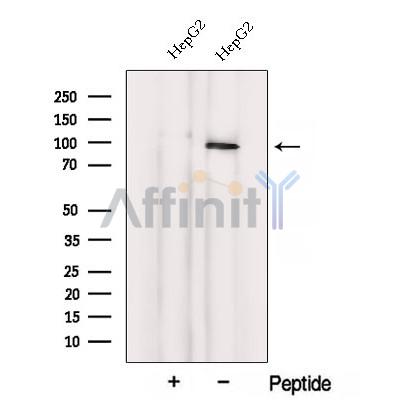VPS41 Antibody - #DF12795
| Product: | VPS41 Antibody |
| Catalog: | DF12795 |
| Description: | Rabbit polyclonal antibody to VPS41 |
| Application: | WB IF/ICC |
| Reactivity: | Human, Monkey |
| Prediction: | Pig, Zebrafish, Bovine, Horse, Sheep, Rabbit, Dog, Chicken |
| Mol.Wt.: | 94 kDa; 99kD(Calculated). |
| Uniprot: | P49754 |
| RRID: | AB_2845756 |
Product Info
*The optimal dilutions should be determined by the end user. For optimal experimental results, antibody reuse is not recommended.
*Tips:
WB: For western blot detection of denatured protein samples. IHC: For immunohistochemical detection of paraffin sections (IHC-p) or frozen sections (IHC-f) of tissue samples. IF/ICC: For immunofluorescence detection of cell samples. ELISA(peptide): For ELISA detection of antigenic peptide.
Cite Format: Affinity Biosciences Cat# DF12795, RRID:AB_2845756.
Fold/Unfold
HVPS41; hVps41p; HVSP41; S53; Vacuolar assembly protein 41; Vacuolar protein sorting 41 (yeast homolog); Vacuolar protein sorting 41 (yeast); Vacuolar protein sorting 41 homolog (S. cerevisiae); Vacuolar protein sorting associated protein 41 homolog; vacuolar protein sorting-associated protein 41 homolog; VPS 41;
Immunogens
A synthesized peptide derived from human VPS41, corresponding to a region within the internal amino acids.
- P49754 VPS41_HUMAN:
- Protein BLAST With
- NCBI/
- ExPASy/
- Uniprot
MAEAEEQETGSLEESTDESEEEESEEEPKLKYERLSNGVTEILQKDAASCMTVHDKFLALGTHYGKVYLLDVQGNITQKFDVSPVKINQISLDESGEHMGVCSEDGKVQVFGLYSGEEFHETFDCPIKIIAVHPHFVRSSCKQFVTGGKKLLLFERSWMNRWKSAVLHEGEGNIRSVKWRGHLIAWANNMGVKIFDIISKQRITNVPRDDISLRPDMYPCSLCWKDNVTLIIGWGTSVKVCSVKERHASEMRDLPSRYVEIVSQFETEFYISGLAPLCDQLVVLSYVKEISEKTEREYCARPRLDIIQPLSETCEEISSDALTVRGFQENECRDYHLEYSEGESLFYIVSPRDVVVAKERDQDDHIDWLLEKKKYEEALMAAEISQKNIKRHKILDIGLAYINHLVERGDYDIAARKCQKILGKNAALWEYEVYKFKEIGQLKAISPYLPRGDPVLKPLIYEMILHEFLESDYEGFATLIREWPGDLYNNSVIVQAVRDHLKKDSQNKTLLKTLAELYTYDKNYGNALEIYLTLRHKDVFQLIHKHNLFSSIKDKIVLLMDFDSEKAVDMLLDNEDKISIKKVVEELEDRPELQHVYLHKLFKRDHHKGQRYHEKQISLYAEYDRPNLLPFLRDSTHCPLEKALEICQQRNFVEETVYLLSRMGNSRSALKMIMEELHDVDKAIEFAKEQDDGELWEDLILYSIDKPPFITGLLNNIGTHVDPILLIHRIKEGMEIPNLRDSLVKILQDYNLQILLREGCKKILVADSLSLLKKMHRTQMKGVLVDEENICESCLSPILPSDAAKPFSVVVFHCRHMFHKECLPMPSMNSAAQFCNICSAKNRGPGSAILEMKK
Predictions
Score>80(red) has high confidence and is suggested to be used for WB detection. *The prediction model is mainly based on the alignment of immunogen sequences, the results are for reference only, not as the basis of quality assurance.
High(score>80) Medium(80>score>50) Low(score<50) No confidence
Research Backgrounds
Plays a role in vesicle-mediated protein trafficking to lysosomal compartments including the endocytic membrane transport and autophagic pathways. Believed to act in part as a core component of the putative HOPS endosomal tethering complex is proposed to be involved in the Rab5-to-Rab7 endosome conversion probably implicating MON1A/B, and via binding SNAREs and SNARE complexes to mediate tethering and docking events during SNARE-mediated membrane fusion. The HOPS complex is proposed to be recruited to Rab7 on the late endosomal membrane and to regulate late endocytic, phagocytic and autophagic traffic towards lysosomes. Involved in homotypic vesicle fusions between late endosomes and in heterotypic fusions between late endosomes and lysosomes implicated in degradation of endocytosed cargo. Required for fusion of autophagosomes with lysosomes. May link the HOPS complex to endosomal Rab7 via its association with RILP and to lysosomal membranes via its association with ARL8B, suggesting that these interactions may bring the compartments to close proximity for fusion. Involved in the direct trans-Golgi network to late endosomes transport of lysosomal membrane proteins independently of HOPS. Involved in sorting to the regulated secretory pathway presumably implicating the AP-3 adaptor complex (By similarity). May play a role in HOPS-independent function in the regulated secretory pathway.
Endosome membrane. Late endosome. Lysosome. Golgi apparatus>trans-Golgi network. Early endosome. Cytoplasmic vesicle>Clathrin-coated vesicle.
Belongs to the VPS41 family.
Restrictive clause
Affinity Biosciences tests all products strictly. Citations are provided as a resource for additional applications that have not been validated by Affinity Biosciences. Please choose the appropriate format for each application and consult Materials and Methods sections for additional details about the use of any product in these publications.
For Research Use Only.
Not for use in diagnostic or therapeutic procedures. Not for resale. Not for distribution without written consent. Affinity Biosciences will not be held responsible for patent infringement or other violations that may occur with the use of our products. Affinity Biosciences, Affinity Biosciences Logo and all other trademarks are the property of Affinity Biosciences LTD.



